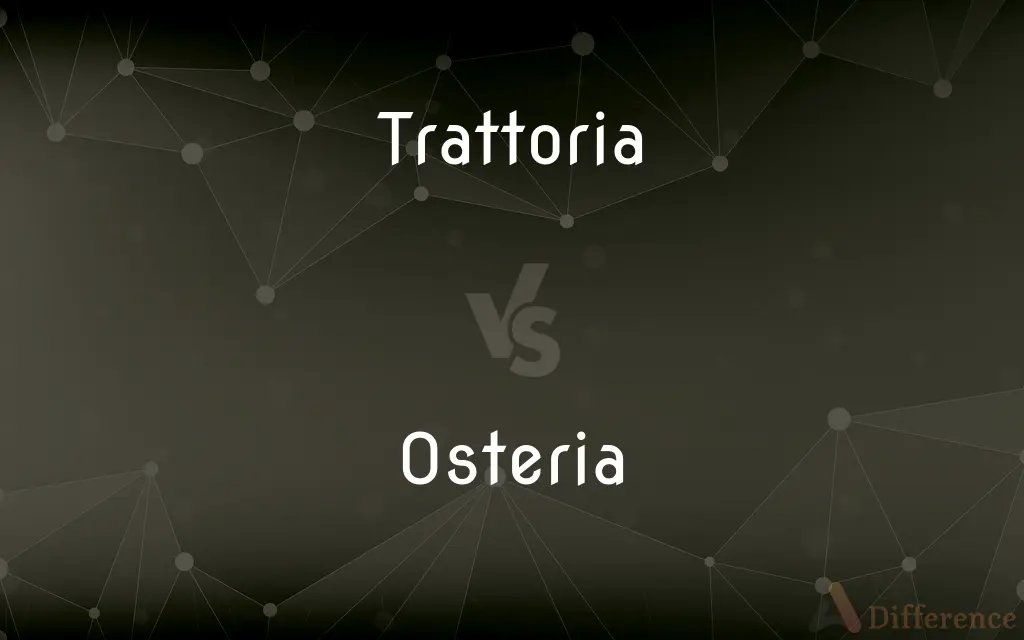Trattoria vs. Osteria — What's the Difference?
By Maham Liaqat & Fiza Rafique — Updated on March 8, 2024
Trattoria is a casual, often family-run restaurant in Italy, known for simple, traditional home-style cooking, while an Osteria is even more informal, traditionally a place serving wine and simple food, now often resembling a tavern or pub.

Difference Between Trattoria and Osteria
Table of Contents
ADVERTISEMENT
Key Differences
A trattoria offers a cozy and informal dining experience, typically less formal than a ristorante but more so than an osteria. The focus is on a straightforward menu featuring local and traditional dishes, often prepared with family recipes passed down through generations. An osteria, historically, was a place serving wine and simple food, but over time, many have evolved into casual eateries similar to trattorias, though they retain a more informal ambiance.
Trattorias usually provide a welcoming atmosphere, where the emphasis is on the quality and authenticity of the food rather than elaborate decor or presentation. Originally, osterias were places for locals to drink and socialize, often without a menu, where the food served was whatever was available that day. Today, some osterias offer a more extensive menu, akin to that of a trattoria, but the atmosphere remains relaxed and unpretentious, with a focus on good, simple food and local wines.
While both trattorias and osterias provide casual dining experiences, trattorias tend to be slightly more formal, focusing more on the food experience, with a broader menu and a homely feel. Osterias, retaining their historical roots, emphasize the social and communal dining experience, often with shared tables, encouraging interaction among guests.
Trattorias are known for their home-cooked style meals, making them popular among those seeking traditional Italian dishes at affordable prices. They often have a family-friendly vibe, with a warm and inviting atmosphere that makes diners feel like they are eating in an Italian home.
Osterias, on the other hand, are great for casual dining and socializing, often attracting a mix of locals and tourists. The informal setting, combined with the focus on wine and simple, hearty meals, makes osterias a favored spot for a relaxed evening out.
ADVERTISEMENT
Comparison Chart
Definition
Casual restaurant with simple, traditional cooking.
Informal place serving wine and simple food.
Formality Level
More formal than an osteria but less than a ristorante.
More informal, similar to a tavern or pub.
Menu
Offers a straightforward menu with traditional dishes.
Originally limited; now may offer a broad menu.
Ambiance
Cozy and family-friendly, focusing on food quality.
Relaxed and social, often with communal tables.
Historical Origin
Designed for affordable, home-style dining.
Originated as a place for wine and light fare.
Compare with Definitions
Trattoria
Trattorias serve traditional, home-cooked Italian meals in a relaxed setting.
We enjoyed authentic pasta at a quaint trattoria in the heart of Rome.
Osteria
Osterias are casual spots for wine and simple, hearty meals.
We stumbled upon a charming osteria where locals gathered for wine and conversation.
Trattoria
Family-run trattorias often reflect regional culinary traditions.
The trattoria, run by the same family for generations, offered a taste of Tuscany.
Osteria
Historically, osterias served as communal gathering places.
The old osteria in the village square has been a meeting place for centuries.
Trattoria
Trattorias provide a more personal dining experience.
The owner of the trattoria greeted us personally, adding a special touch to our meal.
Osteria
The informal ambiance of osterias makes them perfect for casual outings.
Our casual dinner at the osteria turned into an unforgettable evening with new friends.
Trattoria
Trattorias are known for their warm and inviting atmosphere.
The cozy trattoria on the corner became our go-to for comfort food.
Osteria
Modern osterias blur the line with trattorias, offering fuller menus.
The osteria surprised us with a menu that rivaled more formal restaurants.
Trattoria
Many trattorias offer a daily menu based on available fresh ingredients.
Today's trattoria menu featured a special made with locally sourced vegetables.
Osteria
Osterias often emphasize local wines and seasonal dishes.
Each dish at the osteria was paired with a selection from their extensive local wine list.
Trattoria
A trattoria (plural: trattorie) is an Italian-style eating establishment that is generally much less formal than a ristorante, but more formal than an osteria. A trattoria rooted in tradition may typically provide no printed menu, casual service, wine sold by the decanter rather than the bottle, and low prices, with an emphasis on a steady clientele rather than on haute cuisine.
Osteria
An osteria (Italian pronunciation: [osteˈriːa], plural osterie) in Italy was originally a place serving wine and simple food. Lately, the emphasis has shifted to the food, but menus tend to be short, with the emphasis on local specialities such as pasta and grilled meat or fish, often served at shared tables.
Trattoria
An informal restaurant or tavern serving simple Italian dishes.
Osteria
A small local restaurant in Italy.
Trattoria
A small, informal Italian-style restaurant.
Common Curiosities
Do trattorias and osterias serve only Italian wine?
While they focus on Italian wines, especially those local to the region, some may offer a selection of international wines to cater to diverse tastes.
Can you find trattorias and osterias outside of Italy?
Yes, trattorias and osterias can be found worldwide, often run by Italian expatriates or enthusiasts aiming to recreate the authentic Italian dining experience.
Is reservation required for trattorias and osterias?
Reservations are not typically required, especially for osterias, but it's a good idea for trattorias, particularly in tourist areas or for larger groups.
Can vegetarians find suitable options in trattorias and osterias?
Yes, both usually offer vegetarian options, though the variety may vary, with trattorias often having a slightly broader menu.
How has the concept of osterias evolved over time?
Osterias have evolved from simple wine-serving establishments to more food-centric eateries, blurring the lines with trattorias but retaining a casual, social atmosphere.
Are trattorias more expensive than osterias?
Trattorias can be slightly more expensive due to their emphasis on a broader menu and dining experience, but both are generally considered affordable dining options.
What type of service can be expected at trattorias and osterias?
Service is typically friendly and informal, with a focus on making guests feel at home, reflecting the establishments' relaxed dining ethos.
What distinguishes a trattoria from an osteria?
A trattoria is a casual restaurant with a focus on traditional cooking, slightly more formal than an osteria, which is more informal and originally focused on serving wine and simple food.
Are trattorias and osterias suitable for families with children?
Yes, both are generally family-friendly, with trattorias often being more accommodating due to their homely atmosphere.
Do trattorias and osterias have fixed menus?
Trattorias usually have a more consistent menu, while osterias, especially traditional ones, might offer dishes based on daily availability.
Share Your Discovery

Previous Comparison
Disbursement vs. Expenditure
Next Comparison
Cia vs. KiaAuthor Spotlight
Written by
Maham LiaqatCo-written by
Fiza RafiqueFiza Rafique is a skilled content writer at AskDifference.com, where she meticulously refines and enhances written pieces. Drawing from her vast editorial expertise, Fiza ensures clarity, accuracy, and precision in every article. Passionate about language, she continually seeks to elevate the quality of content for readers worldwide.














































